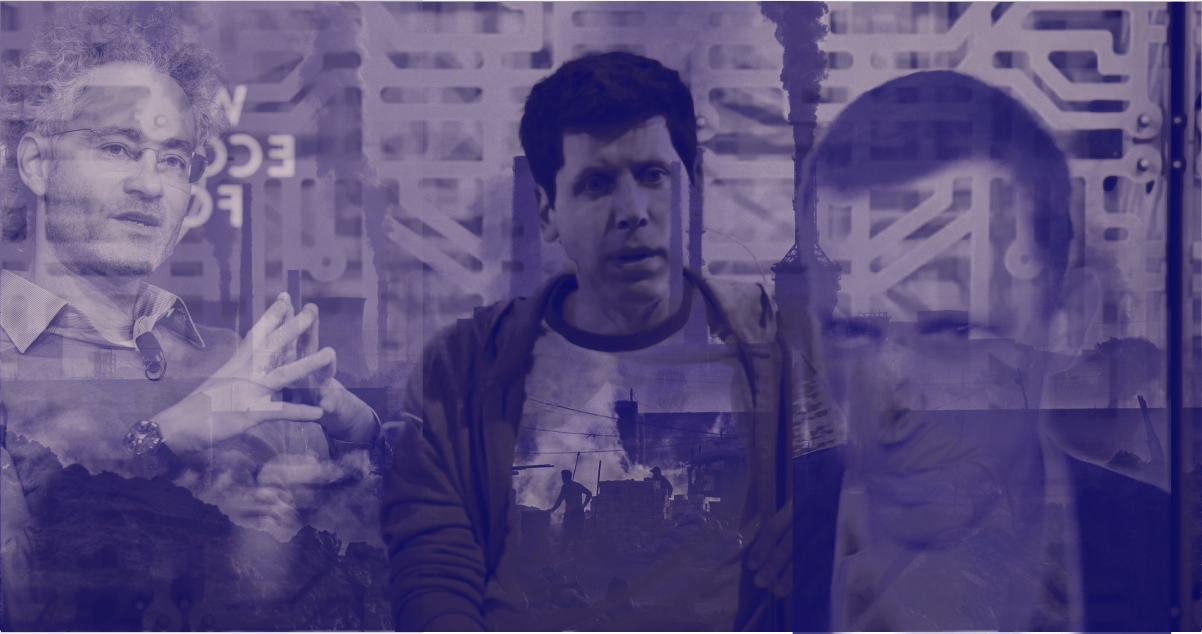So-called 'artificial intelligence'—the machinery more accurately known as 'Large Language Models'—is a weapon of the enemy. It has not earned that status by doing anything qualitatively new. The Israeli genocidaires never needed an LLM to make kill lists (such as their beloved “Where's Daddy?” Or “Lavender” AIs),[1] nor have the American Gestapo. The Immigration and Customs Enforcement agency were able to target, disappear, and deport people long before the help of LLM-generated lists, and the smearing of anti-Zionist activism long preceded the production of articles scraped from the bottom of the ‘AI’ barrel.[2]
Such violence is not an innovation of the neoreactionary tech billionaires in their alliance with the fascist political movements as these forces ascend to apparent hegemony. What these machines do achieve is a rapid acceleration of the targeting process, the creation of these kill and deportation lists; speeding up output production from datasets: therefore, an exponential increase in the number of targets. Whether they are accurate or not is beside the most important point: these machines produce prolific reports, images, and identifications from their input datasets.
This increase in outputs and targets augments these search and purge processes. The datasets produce self-referential objects that serve as support, justification or ‘evidence’ to inform the violence perpetrated by the state. The objects in question may be lists of people to be deported, detained, or murdered, condemnatory articles, or representations of data which justify the withholding of resources by presenting political decisions with a computed, ‘neutral’ shine. These machines manage data on behalf of their owners. Specifically, they serve the collective interests of the fraction of the owning class—capital as owned by tech companies—which has allied itself with the state and its political leadership. As Gareth Watkins at the New Socialist recently pointed out, the imposition of these machines into almost every existing online service, search engine, operating system, governmental institution, and workplace, is a matter of class solidarity across the ruling class:
The capitalist class, as a whole, has made a massive bet on AI: $1 trillion dollars, according to Goldman Sachs – a figure calculated before the Trump administration pledged a further $500 billion for its ‘Project Stargate’... This isn’t just about utility, it’s about aligning themselves with the tech industry.[3]
The tech industry is awash with hype and sci-fi prophecies of Mars colonization and utopian fantasy. Marc Andreesen, co-founder of the Venture Capital firm Andreesen-Horowitz, summarizes the promise of technological salvation in his Techno-Optimist Manifesto with some choice quotes I've assembled here:
Artificial Intelligence is best thought of as a universal problem solver.
Give us a real world problem, and we can invent technology that will solve it.
We believe the techno-capital machine of markets and innovation never ends[4]
Do not be tempted into thinking that their ‘we’ includes us.
The techno-capitalists—an ultimately redundant term–believe that the only way forward is theirs. Unsurprisingly, this coincides with the tech-sector investments on which the owning class has bet their capital. With characteristic hubris, they believe that they are smart enough to solve all of our problems, so long as we do not challenge their power, or advocate for systems of collective ownership and solidarity that would threaten it.[5]
So long as we do not disrupt the machines or challenge who owns them, we are told to sit back, trust the process, and hand over our money. They may ask for our data too, but in truth, they no longer need to. Microsoft, Apple, and Amazon are hegemonic in the production and ownership of digital infrastructure and the proliferation of consumer technology. State apparatuses have become institutionally dependent on Big Tech, for example through the integration of Palantir’s data technologies into the infrastructure of the U.S. Military and the NHS. At the same time, every time we use a platform, be it Google search or social media, produces data for these systems. Every online purchase, every interaction that passes through any circuit of digital metrics, saved data, or computational recording, produces data as elements of a set which may be bought and sold. Taking one recent example: whoever buys the now-defunct 23andMe platform will inherit the DNA data of seven million former customers. People signed up for such services in order to work out where they may be from, a racial curiosity not limited to users, but shared, quite openly, by tech entrepreneurs and fascists.
Large Language Models require training, and for this they require vast datasets: archives of our digitized activity, movement, history, interactions, transactions, images, communications. Rarely do we own this data ourselves: the platforms do. The greater our digitized existence, the greater the wealth of the platform owners. It takes no particular foresight to guess what will be done with this information; we can already see what they intend, what’s already being done in real time, in plain sight.
Data sits at a precarious intersection between knowledge and appearance, as a recording or representation. If Baudrillard has been confirmed by anything historical as of late, it is that this recording is often treated by institutions as having a greater reality than that which it purports to record. Yet we don’t need high theory to understand what the brutality of experience is already teaching those in the crosshairs of our contemporary institutions. Consider, for instance, the application process for in-work disability payments in the United Kingdom. Under the Labour Party, the Department for Work and Pensions (DWP) have changed the criteria for assessment, making it significantly harder for disabled people to claim the Personal Independence Payment. The material reality of the situation—the disabled person’s body—has not changed in any way that would justify a reduction in support: if anything their circumstances have often worsened under the cumulative weight of ongoing COVID-induced disablement, rising prices, poor air quality, and the austere demolition of public health services. Rather, it is the data—the reports assigning numerical points to their ability to complete daily tasks such as showering, getting dressed, and other everyday tasks—that has been recalibrated. As a result, the same living condition now produces a different score, such that the sum total often no longer qualifies them for support. This will, by the DWP’s own figures, condemn a quarter of a million people to absolute poverty.[6]
The material reality of the disabled body need not change; only the relations between labour, capital, and those fractions of labor once organized enough to contest it. Data doesn’t need to be knowledge, it just needs to be recognized as an abstracted, digitized, and mythologized quantification which can serve as a justification—credible or not—to fill in the institutional need for any justification at all. It is a box-ticking exercise in bureaucratic cruelty.
Today, correspondence from benefits claimants appears to be processed by an LLM called “Whitemail”.[7] A government paper boasts that “AI technology has further increased the speed at which we are able to identify vulnerable people”.[8] This has clearly been successful, although it’s not as if the DWP needed the help to socially murder the disabled: this is mostly a hype and labour-saving exercise.[9] The British state has found the vulnerable—and found them wanting. This includes those already identified, now subjected to reassessment and systematic removal of Personal Independence Payments. Thousands of disabled people will be dragged into destitution, naked social murder. It is not hyperbolic to believe that our governments want these machines for social control and social murder. Indeed, given that the UK is an active participant in Israel’s genocide on the side of intelligence gathering and therefore data production[10] this may be part of the appeal.
But this has all happened before, hasn’t it? The Palantir, Microsoft, Amazon, or Google of today is only a repetition of the bourgeois techno-capital configuration of yesterday—I am talking about IBM and their role in the Holocaust. This is a historical constellation of facts which was not brought to public consciousness until Edwin Black wrote IBM and the Holocaust, and often goes unrecognized today. To this extent, it is worth quoting Black at length:
IBM Germany, known in those days as Deutsche Hollerith Maschinen Gesellschaft, or Dehomag, did not simply sell the Reich machines and then walk away. IBM's subsidiary, with the knowledge of its New York headquarters, enthusiastically custom-designed the complex devices and specialized applications as an official corporate undertaking. Dehomag's top management was comprised of openly rabid Nazis who were arrested after the war for their Party affiliation. IBM NY always understood—from the outset in 1933—that it was courting and doing business with the upper echelon of the Nazi Party. The company leveraged its Nazi Party connections to continuously enhance its business relationship with Hitler's Reich, in Germany and throughout Nazi-dominated Europe.
Dehomag and other IBM subsidiaries custom-designed the applications. Its technicians sent mock-ups of punch cards back and forth to Reich offices until the data columns were acceptable, much as any software designer would today. Punch cards could only be designed, printed, and purchased from one source: IBM. The machines were not sold, they were leased, and regularly maintained and upgraded by only one source: IBM. IBM subsidiaries trained the Nazi officers and their surrogates throughout Europe, set up branch offices and local dealerships throughout Nazi Europe stalled by a revolving door of IBM employees, and scoured paper mills to produce as many as 1.5 billion punch cards a year in Germany alone. Moreover, the fragile machines were serviced on site about once per month, even when that site was in or near a concentration camp. IBM Germany's headquarters in Berlin maintained duplicates of many code books, much as any IBM service bureau today would maintain data backups for computers.
I was haunted by a question whose answer has long eluded historians. The Germans always had the lists of Jewish names. Suddenly, a squadron of grim-faced SS would burst into a city square and post a notice demanding those listed assemble the next day at the train station for deportation to the East. But how did the Nazis get the lists? For decades, no one has known. Few have asked. The answer: IBM Germany's census operations and similar advanced people counting and registration technologies. IBM was founded in 1896 by German inventor Herman Hollerith as a census tabulating company. Census was its business. But when IBM Germany formed its philosophical and technologic alliance with Nazi Germany, census and registration took on a new mission. IBM Germany invented the racial census—listing not just religious affiliation, but bloodline going back generations. This was the Nazi data lust. Not just to count the Jews—but to identify them.
People and asset registration was only one of the many uses Nazi Germany found for high-speed data sorters. Food allocation was organized around databases, allowing Germany to starve the Jews. Slave labor was identified, tracked, and managed largely through punch cards. Punch cards even made the trains run on time and cataloged their human cargo. German Railway, the Reichsbahn, Dehomag's biggest customer, dealt directly with senior management in Berlin. Dehomag maintained punch card installations at train depots across Germany, and eventually across all Europe.[11]
As I write this, ICE are working with Palantir to “complete target analysis of known populations”, that is, to update their search tools to identify and deport people from the United States.[12] In the UK, Palantir is headed by the grandson of Oswald Mosley, the one time aristocratic head of the British Union of Fascists —our enemies are efficient, but not subtle. Palantir, either despite or because of their determination to aid processes of state persecution, remain under contract to provide the data infrastructure for the National Health Service, which itself is no stranger to segregation and social murder through the privation of care. We can already see this with the state of trans healthcare provisions in this country, which remain segregated through a system of separate ‘Gender Identity Clinics’ at the same time as they are being destroyed through austerity and transphobic legislation.[13]
Nonetheless, even companies such as Palantir are not truly the vanguard of fascism. They are the shovel merchants in a gold rush of institutionalised cruelty. The current crop of tech companies are gearing themselves up to perform the same role that IBM played in Nazi Germany, alongside older firms such as IBM itself, which as a company never faced justice for what it did and may still be doing.
Technological intensifications of the process of arrest through data processing are accelerations of slavery. Consider the United States, which notoriously excluded prison slavery from its abolition in the 13th amendment and is currently exporting slaves to El Salvador on the basis of its own data: reports of which appear to indicate that any brown man with a tattoo is likely to be pegged as a gang member.[14] Even if they were, this would be unacceptable in any circumstance. As Mohammed El-Kurd teaches us in his book Perfect Victims, any such appeal to a higher moral quality of a victim is complicity with the oppressor and their discourse, their data. We do not question the justification for an oppressive act we are resolutely opposed to, for it is the act itself which is in question, and it is the enemy who hides behind the noise of ‘discourse’ about deserving and undeserving victims of their own violence. These machineries help the enemy to find their targets faster: accelerating the logistics of social murder, genocide, assassination, deportation, and enslavement. What is to be done? The answer to this question—or at least an intimation thereof—can be found on the level of infrastructure and the political economy of data.
From Dependence to Deceleration
It should not be forgotten that a significant part of the appeal of these new technologies is their utility as ‘labour-saving’ devices. Yet this is only true of these machines as they are marketed, as they appear qua the commodities or commodified services which they engender. So-called ‘AI’ does not reduce labour, rather it diffuses labour into thousands of smaller labours, which it renders practically invisible to the user. Data is dead labour, and it is the dead labour of thousands of data-moderators and ‘micro-workers’, who are paid paltry wages—often in refugee camps or spread across the Global South—to label images, correct false outputs, and generate source data for these machines.[15]
Data is also generated by all of us every time we use a platform or make a movement or purchase that is recorded (a Tesco Clubcard, much like any other loyalty card for a supermarket, produces huge amounts of local data on branches, purchases, and their frequency. It’s not a discount, it’s a reward for data produced). It may not feel like work, but it is nonetheless a productive labour––consumption produces data and plays its part in the circulation of capital and commodities. If your job is to send emails, then your job is primarily to spend money. Nonetheless, this remains the appeal to Our Betters: invisibilized labour is cheaper, if not free, and so their costs go down as if labour was being removed from the equation. This means that it is increasingly possible—and the tech companies hope for this—that more and more institutions and companies will become dependent on these machines, for which they’ll pay subscriptions, which will enrich the owners of these machines as ‘service providers’. This may be already occurring, if we note how Trump’s new reciprocal tariff rates unsurprisingly resemble those generated by an LLM.[16]
The growing dependence of smaller businesses and governmental agencies on these machines and those who own them reflects a deeper structural dependence. The techno-capitalist bourgeoisie has staked substantial portions of its capital on the success of these technologies, of these machines. Their project is to transfer this dependency outward, such that they become inextricable from the daily life of their subscribers.
The techno-capitalist gambit is this: ‘we will make them dependent on us, and then the cost of getting rid of us will be too high—institutional collapse and logistical chaos will be the price of rebellion.’ This is a war of the subjugation of labour and the management and disposal of surplus populations. As a vast and international program for the reduction of labour costs, this is a class war. As an international class war it is therefore a colonial war. Firstly, on the level of raw materials, as their machines require precious metals such as Coltan from places such as the Democratic Republic of the Congo and fossil fuels sourced through the circuits of global imperialism. Secondly, on the level of the international use of computational power for the purposes of war through the internet, cloud storage systems, and their infrastructure. As AP report:
Microsoft and the San Francisco-based startup OpenAI are among a legion of U.S. tech firms that have supported Israel’s wars in recent years.
Google and Amazon provide cloud computing and AI services to the Israeli military under “Project Nimbus,” a $1.2 billion contract signed in 2021 when Israel first tested out its in-house AI-powered targeting systems. The military has used Cisco and Dell server farms or data centres. Red Hat, an independent IBM subsidiary, also has provided cloud computing technologies to the Israeli military, and Palantir Technologies, a Microsoft partner in U.S. defense contracts, has a “strategic partnership” providing AI systems to help Israel’s war efforts.[17]
Calling it ‘cloud’ computing is a master-stroke of marketing. The writer Dan McQuillan, whose book Resisting AI is an essential resource for the social critique of computing, cuts through the bluster accordingly:
Unlike actual clouds, which transport life-giving moisture from the seas to the land, the AI cloud sucks up scarce water resources. It shouldn't be called 'The Cloud' it should be called 'the Drought', and we should say "that large language model runs in The Drought"[18]
Drought computing is part of capital’s war on the Earth itself: in its colonial and fascist appropriation of resources, it draws the diagram which links extraction to extermination. The term ‘cloud’ harbours a colloquial idealism, as if it was all ‘up there’ and beyond us. But we know where the computing happens, and thanks to cloud computing, the violence of the imperial periphery can be commanded, informed, and directed from regions of the core in an accelerated manner, enabled by the computational power housed within the confines of the data centres.
These places hold the server banks, the data (or copies thereof), the physical infrastructure of mass computation.[19] In their resource intensive operation, their political function, and their asset value for capitalists. Data centres can be thought of as toxic network infrastructure, similar to oil pipelines. As such, they are vulnerable.
Militant worker action can prevent them from being built, and indeed it is in the construction phase that they are at the most vulnerable. In the same way that shipments of weaponry and weapons components can be disrupted by dockworkers, construction can be halted by labourers. Unlike the pipelines, data centres are also often built close to populated regions, and hence closer to where people can stop them. In 2024 it was reported that 72 data centre projects were to begin construction in the UK, including in and around London.[20] The enemy don’t usually build their pipelines so close, and with so few jobs to show for it. I believe that it is strategically and practically necessary for workers’ movements, Palestinian solidarity movements, ecological movements, and communists to focus attention on this infrastructure in both local and global terms. That is, how can we stop the spread of data centres, how can we impede the institutional cruelty so-called 'AI' is intensifying, and how can we take the fight to Silicon Valley and its partners in our own capitalist states? Data centres function as an increasingly central part of the nervous system of an imperial, techno-capitalist order. Democratic politics holds the right to question their present and future existence. Any genuinely democratic power for our times, as I have argued, is better off without them.
The process of democratization, to borrow a term from McQuillan, is decomputation, it is a refusal of the tyranny of abstract domination and machinic enslavement before the owners of technology. It is a necessary part of any communist response to the current moment. We find ourselves in the midst of an accelerating class war, and one which will require us to revisit older Marxist perspectives on the historically progressive nature of technological developments. We must return to one of Walter Benjamin’s theses, that “revolutions are not the train ride, but the human race grabbing for the emergency brake.”[21]
Yuval Abraham, “‘Lavender’: The AI machine directing Israel’s bombing spree in Gaza”, +972 Magazine, 2024. ↩︎
Thomas Maxwell, “Yale Suspends Palestine Activist After AI Article Linked Her to Terrorism”, Gizmodo, 2025. ↩︎
Gareth Watkins, “AI: The New Aesthetics of Fascism”, New Socialist, 2025. ↩︎
Marc Andreessen, “The Techno-Optimist Manifesto”, 2023. ↩︎
In the same “Techno-Optimist Manifesto” Marc Andreesen identifies this threat outright: “Our enemy is statism, authoritarianism, collectivism, central planning, socialism.” ↩︎
John Pring, “Labour’s cuts to PIP will drag a quarter of a million people into absolute poverty, DWP figures show”, Disability News Service, 2025. ↩︎
Mackenzie Ferguson, “DWP Unveils Controversial 'White Mail' AI: Transforming Benefit Systems at What Cost?
”, 2025. ↩︎Mel Stride, “DWP use of artificial intelligence (AI)”, UK Department for Work & Pensions, 2023. ↩︎
See my article “Eugenic Austerity”. ↩︎
Iain Overton, “Britain sent over 500 spy flights to Gaza: AOAV study reveals the scale of British intelligence gathering above Gaza, raising fears of complicity in Israeli war crimes”, AOAV, 2025. ↩︎
Edwin Black, IBM and the Holocaust, Dialog, 2012, pp. 9-10. ↩︎
Joseph Cox, “ICE Just Paid Palantir Tens of Millions for ‘Complete Target Analysis of Known Populations’”, 404 Media, 2025. ↩︎
June, “Supreme Court attacks trans people – the fight for liberation goes on”, rs21, 2025. ↩︎
Karla Ostolaza, “ICE’s focus on tattoos is part of a long tradition of profiling”, MSNBC, 2025. ↩︎
For more information, see the extract from my book The New Flesh and its sources. ↩︎
Alexandra Scaggs, “Reciprocal tariffs: you won’t believe how they came up with the numbers”, Financial Times, 2025. ↩︎
Michael Biesecker, Sam Mednick, & Garance Burke; “As Israel uses US-made AI models in war, concerns arise about tech’s role in who lives and who dies”, The Associated Press, 2025. ↩︎
Stephanie Susnjara & Ian Smalley, “What is a data center?”, IBM, 2024. ↩︎
Megan Pounds, “What’s driving the surge in data centre construction projects in the UK?”, 2024. ↩︎
Walter Benjamin, Selected Writings, 1938-1940, Harvard University Press, 2003, p. 402. ↩︎








